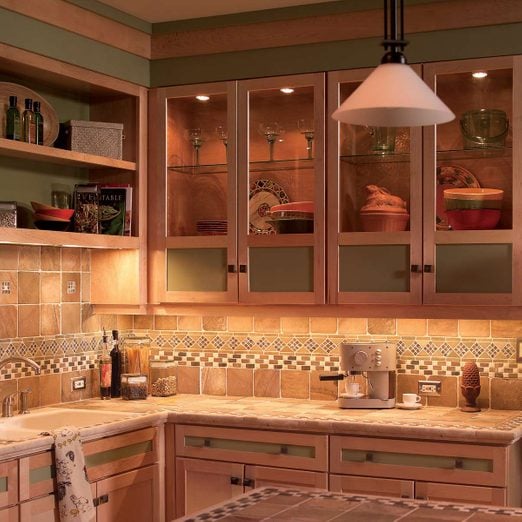Do you find yourself frequently struggling to troubleshoot problems with your under cabinet lighting? Look no further! This comprehensive guide will provide you with all the insight needed to fix any common issues you may be encountering.
Here, you’ll learn how to troubleshoot wireless under cabinet lighting and find a solution quickly and easily.
When it comes to wireless under cabinet lighting, there are a number of potential problems that can arise. While installing your lights is easy, troubleshooting any of the described issues can be intimidating to take on. To ensure you get the most out of your light fixtures and enjoy their benefits without unnecessary hassle or worry, we’re providing detailed steps for troubleshooting several common problems in this complete guide.
Common problems can range from power supply issues to interference from other nearby appliances or devices. With that said, let’s begin by exploring some of the basics surrounding wireless under cabinet lighting, including the components involved and an introduction to available solutions.
Common problems with wireless under cabinet lighting
Wireless under cabinet lighting is a great convenience, providing you with an easy way to add illumination without incurring the cost and hassle of a full-scale electrical remodel. However, like all products, it can experience technical problems from time to time. Below are a few of the most common issues you may encounter when troubleshooting your wireless cabinet lighting system.
- The lights won’t turn on: This is usually caused by incorrect installation or broken batteries. If you have used the Easy Link Technology during installation and the lights still won’t turn on, try replacing the batteries and making sure all connections are secure.
- Lights seem too dim: Make sure that the LED strips have been installed correctly and that they are not clogged with dust which could be blocking light from entering into your cabinet space. Additionally, check to make sure that all wires are securely connected and that there are no breaks in the line which may also be contributing towards dim output power levels in your system.
- Lights flicker or turn off unexpectedly: This can occur if there is interference within your home network such as Wi-Fi signals or other electronic devices running on similar frequencies as your wireless under cabinet lighting system can interfere with signal strength and cause unexpected power fluctuations in the LEDs causing them to intermittently flicker or shut down altogether. To remedy this issue try repositioning routers, Bluetooth devices and other electronic appliances away from any areas where they may conflict with your wireless cabinet lighting system frequency bands.
- Lights appear unstable or discolored:If colors seem uneven, changeable, faded or brights spots appear on some of your LED strips it is an indication that something within your wireless under cabinetlighting system either needs replacing of being re-calibrated for optimal signal strength performance among all LED controllers and components installed throughout your home’s cabinetspace.
Inconsistent lighting or flickering
Inconsistent lighting or flickering is usually caused by an insufficient power supply or incorrect wiring. To troubleshoot these problems, make sure the fixtures are securely screwed into the junction box and power is enabled. If these checks don’t resolve the issue, use a multimeter to check whether there is a rift in the wires and their current state of functioning.
If there are loose or broken wires, replace them with new ones after confirming the voltage and polarity requirements of your lights. Another possible cause of flickering might be interference from other electromagnetic sources like dimmers controlling nearby light fixtures or microwave ovens in operation nearby.
To address this, consider using wireless lights that don’t require direct wiring and also switch off any unnecessary devices when using your lighting system.
Difficulty with turning on/off
Issues with turning on/off your wireless under cabinet lighting can be caused by several possible factors. It is important to take a step-by-step approach in order to identify and address the issue. Here are some steps you can take to troubleshoot and address problems with turning on/off your under cabinet lights:
- Check the batteries: Make sure the batteries in the switch or remote control are fully charged, or that they have not been left out too long and depleted their charge.
- Ensure they are properly synced: Turn off all of your lights, then turn them back on and sync them one at a time starting from the furthest light from the switch or remote. If you find that one light isn’t turning back on, unplug it from its power source, wait 30 seconds, then plug it back in and sync it again following the same process as before.
- Check for interference: Wireless signals can sometimes be blocked by other electronic devices, so make sure there aren’t any competing signals available in your environment. This includes other appliances such as microwaves or bluetooth headphones that may cause interference with your lights’ signal strength.
- Reset your lights: If all else fails, you may have to reset your entire system by disconnecting all of the lights from their power sources and waiting 60 seconds until they turn off completely before reconnecting them again one by one beginning with the furthest light from the switch or remote control first and ending at the closest light to it last. This should restore optimal connection between devices so you can turn on/off your under cabinet lighting as expected.
Remote control not working
Troubleshooting a non-functioning remote control for your wireless under cabinet lighting system can be a challenge, as there are several potential causes. Before attempting to solve the problem, it is essential to gather all the relevant information related to your system such as manufacturer’s name and model number. Once you have this information available, you can begin to effectively identify and solve the problem.
One of the most common problems is when the remote does not appear to be syncing with the lighting system. This could occur due to improperly paired frequencies or defective batteries in either the remote or the receiver module on the fixtures. To rule out any frequency issues, it is helpful to try using either a fresh set of batteries in both the remote and receiver modules or using another set of known functional batteries that are not drained from regular usage.
In addition, if wireless interference from other appliances is occurring in your home or office space, this could also be disrupting radio signals causing disruptions in connection between your remote and fixtures. To determine whether this is an issue, it can be beneficial to move either yourself or your appliance around until your connection is reestablished between you and your lighting components. In extreme cases where other appliances do not seem to be causing signal disruption but frequency conflicts are still suspected then resetting either one of more receivers may offer some help correcting problematic signals related issues on both sides (remote & receivers).

Troubleshooting solutions
When it comes to wireless under cabinet lighting, you can quickly identify potential problems by methodically going through each possible source of the issue. To help guide you in the process, here are a few tips on how to troubleshoot common issues with your wireless under cabinet lighting.
- Check the power: The first step is to check whether the problem lies with the power supply or not. If your lights won’t turn on, make sure they are plugged in and all cables are connected properly before moving onto other sources of the issue. Additionally, check if your switch is on, ensure that any outlets it is connected to are working properly, and examine outlet testers for any other surprising power issues.
- Check the bulbs: If your lights still won’t turn on after ensuring proper power supply, then try changing out all bulbs as a potential solution. Replace halogen with LED bulbs or vice versa depending on what type of lightbulb your fixtures use – halogen lamps may require higher wattage than what’s supplied by an LED model’s driver/transformer assembly. Additionally, test each lightbulb individually using an appropriate voltage meter to rule out bulbs as potential causes of the issue at hand.
- Physically inspect connections: After ruling out a possible bulb issue, inspect all connection points from sensors & switches to lights and wiring harnesses located behind them – look for worn or frayed wires or loose connections at any plug-in terminals. Securely fasten & reconnect every connection as necessary until no further loose connections can be detected along any portion of this chain – this should return power where applicable and rectify most operational issues with wireless under cabinet lighting systems that don’t work due to improper connections/connector malfunctions.
Check the power source and connections
When you’re dealing with a wireless under cabinet lighting system, the most common problems are related to power issues. Before attempting any troubleshooting, you should make sure that the power source is properly connected to both the lights and the switch. Also check that the wall outlet is properly providing power to both components. If your outlet isn’t getting any power, it may be necessary to replace it or reset a circuit breaker.
The next step in troubleshooting a wireless under cabinet lighting system is to inspect all of the connections and wires for signs of damage or disconnection. If any of these elements appear frayed or damaged in any way, they will need to be replaced before continuing any further troubleshooting. Even if no visible signs of damage are present, it is still important to confirm that all connections are secure and free from obstruction for optimal performance. Once all of the wiring is checked and confirmed as secure, you can then proceed with diagnosing other potential sources of malfunction.
Replace batteries
Replacing batteries is the simplest way to troubleshoot wireless under cabinet lighting issues. If your lights are losing power or become dim, it may be because of old or worn out batteries. Most wireless lights use standard AA, AAA, or button-style batteries which can be purchased from most hardware stores and online retailers.
To replace the batteries, unscrew the light base and insert new batteries with the positive side facing up for best performance. Close the light base to secure the battery and turn on your lights to test them out.
If you are still experiencing an issue with your lighting, you may need to contact customer service for further assistance and troubleshooting steps.
Verify proper installation and positioning
Verifying proper installation is a critical step when troubleshooting problems with your wireless under cabinet lighting system. Before beginning, review the manufacturers’s installation instructions to ensure you’ve properly installed and positioned each component of your system.
Check your fixtures for any signs of stress, damage, or incorrect mounting. Make sure that all your wire nuts are secure and that there are no frayed wires. Be sure to check the power strips for any possible electrical issues or loose connections as well.
Next, confirm that all switches in the system are properly connected and aligned with their receivers. Verify that drywall anchors have been used where necessary to secure the products in place on unfinished wood cabinets or walls. For hardwired units, use an appropriate voltmeter to make sure the connections are solid and inspect for shorts or live sparks within the wiring circuits.
Also note the distance between fixtures and their receiver; greater distances may cause difficulty when attempting to turn units on/off remotely via a handheld switch or wall mounted dimmer switch controller. In addition, make sure that no objects will be blocking radio frequency (RF) signals from components once installed. The ideal separation between tracks should be at least 4-6 inches; however it is best practice to keep them further apart when possible (8-10 inches recommended).
Reset the light or remote control
Resetting the light or remote control is an easy and common solution for resetting the wireless under cabinet lighting system. This can be done by following the instructions below.
For lights:
- Turn off both sides of the switch that controls your under cabinet light for five seconds.
- Toggle one side of the switch on and off four times, then toggle the other side four times.
- Resetting will be complete when you see quick flashing on your under cabinet light.
For remote control:
- Remove all batteries from remote and press any button several times to ensure there is not any remaining power stored in it before replacing back all batteries again after 5 seconds of no power time has passed.
- To eliminate interference from other nearby devices, relocate your receiver to a different area in your kitchen where it won’t come into contact with heavy metal or metal mesh cabinets or drawers above or below it which may cause a hindrance to its signal reception capability. The optimal distance should be between three feet to five feet away from where your remote is located; this should allow for ample space for uninterrupted transmission range reception by both devices free of obstruction from metal objects in between.
- Press any button from the remote pointing toward its receiver. When you see fast flickering at the end, that means reset has been completed successfully. Remote needs to be pointed towards receiver for all future operations such as switches ON/OFF, dimming and changing color temperature etc.
Conclusion
This guide has provided an overview of troubleshooting common problems with wireless under cabinet lighting. To conclude, here is a summary of the key points to remember when dealing with wireless lighting issues:
– Check if all the wires and connections are secure.
– Make sure the wiring and circuits are properly installed and that any additional wiring is not interfering with other electronic devices.
– Check the main power source, such as a transformer or plug, to ensure it is properly connected and operating safely.
-If there are any problems, contact a professional for further assistance.
Hopefully, this guide has helped you understand all the basics in regards to troubleshooting your under cabinet lighting system. There may be no single solution for every problem you encounter but with patience and perseverance, you can find the right remedy for your particular situation. If nothing else works, don’t hesitate to contact an expert who specializes in wireless lighting systems and they can assist you further.
FAQ’s
How do you troubleshoot under cabinet lighting?
To troubleshoot under cabinet lighting, first check the power supply for any malfunctioning components, or check for faulty wiring. Then inspect the fixtures and bulbs and replace any that are broken or burnt out. Finally, ensure that the switch controlling the lights is in the correct position and functioning properly.
How do I troubleshoot my LED lights?
To troubleshoot LED lights, check the power source to make sure it is functioning properly, inspect the switch to ensure it is turned on and check the connection on the light itself. If these steps do not solve the issue, consider replacing the LED bulb.
Why is my under cabinet fluorescent light not working?
The reason may vary. It could be a blown fuse, burned out bulb, improper wiring, faulty switch, or a tripped circuit breaker.
How do you troubleshoot an LED light driver?
To troubleshoot an LED light driver, first check the power source to ensure it is providing the correct voltage. Test the connections between the driver and fixture. Inspect the components for any loose connections or burnt wires. Verify wiring is following the proper wire diagram. If the driver is still not working, check for any blown fuses or blown out LEDs. Finally, replace the driver if necessary.
What are the most common lighting problem?
The most common lighting problems are inadequate lighting, light bleed, uneven lighting, poor color temperature, poor white balance, and restricted lighting angles.
How do you troubleshoot lighting?
To troubleshoot lighting, first check the power source, fuses and/or circuit breakers to make sure the power is on. Check to see if the wiring and outlets are working. Check the bulb to make sure it is screwed in properly. If the power and wiring are working, replace the bulb. If the bulb is not the issue, check for a loose connection or wiring damage. If all of these steps fail, contact a licensed electrician for assistance.
When troubleshooting a lighting fixture What is the first thing to do?
The first thing to do when troubleshooting a lighting fixture is to check if the power is working correctly. Check if the switch is on and if any circuit breakers have tripped. If the power is working correctly then check the wiring connections, lamp and ballast.
What causes under cabinet LED lights to flicker?
Under cabinet LED lights can flicker due to issues with power supply or loose connections. Loose wiring and poor installation can also be factors. In many cases, adjusting the voltage slightly can stop the flickering.
What are common causes of LED light failure?
Common causes of LED light failure include poor thermal management, inadequate voltage or current for driving the LED, improper flux binning, inadequate cooling, bad electrical connections, and failure of power supply units.
What are the main causes of LED failure?
The main causes of LED failure are heat, current or voltage surge, poor connection/soldering, light degradation and improper design.
See more-
- Best guitar cabinet 2023
- Best cabinet primer 2023
- Best 2×12 guitar cabinet 2023
- Best kitchen pantry cabinet 2023
- Best storage cabinet 2023


